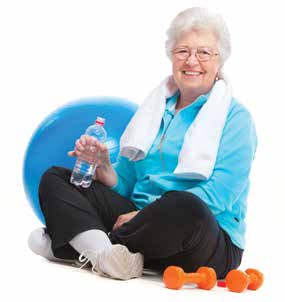Keep Cool and Hydrated

by Paula Allia PT, DHSc, MTC, OCS
The summer weather in Southwest Florida has been very hot and humid. August and September are always hot and usually a minor transition in weather occurs in mid-October. The average temperature in August and September is 93 degrees with a low of 74 versus 88 and a low of 69 in October. As in July, these next three months of hot weather warrant all to take caution against overheating.
Water is crucial to our body for survival and makes up over 70 percent of the body. Not only is water pertinent to helping to cleanse the body, it is used in many chemical reactions in the body.
First, if dehydrated, the body will leach the fluids out of your bloodstream and the normal blood counts may be altered.
Secondly, water helps lubricate the body and helps normal liver, kidney, bowel, and other bodily functions. Finally, every single muscle contraction utilizes something called adenosine triphosphate (ATP). The chemical reactions that produce this ATP as our energy source are anaerobic (without oxygen) and aerobic (with oxygen) metabolism, how we break down our food sources.
 To split and use this ATP in the body, water is needed and if not, muscle contractions in exercises as we know them could not exist. All of us exercise to some extent. Simple exercises to get up and down from a chair and walking with a walker use this ATP while runners, cyclists, and other exercises use a lot more to complete. All need adequate water in the body to allow for normal body functions and for the breakdown of this ATP for energy.
To split and use this ATP in the body, water is needed and if not, muscle contractions in exercises as we know them could not exist. All of us exercise to some extent. Simple exercises to get up and down from a chair and walking with a walker use this ATP while runners, cyclists, and other exercises use a lot more to complete. All need adequate water in the body to allow for normal body functions and for the breakdown of this ATP for energy.
It is common that when I ask people if they drink enough water, the response is usually, “Yes.” The question arises on the amount of water that we should intake.
As a rule, it is safe to say that we should drink half of our body weight in ounces per day. At that point, most people do the calculations and then realize that they do not drink nearly enough.
In the heat of the summer and when exercising, one must really pay attention to water intake.
One of the ways that we release heat and try and cool our body is sweating. Losing fluids through our glands and skin allows for evaporation and thus we get a cooling effect. Everybody’s cooling and sweating mechanisms do vary as some sweat a lot more than others. Actually, if you go into a heat stress mode, sweating usually increases but as you get toward heat stroke, the sweating stops and your body can go into overheating into a life threatening situation.
Now that you understand how much water you need, planning to drink throughout the day is pertinent to your everyday health. How do you reach the right goals? The idea is to take in fluids throughout the day in small amounts. Not drinking then drinking a substantial amount is hard on your kidneys. Small amounts of water for hydration is key along with having the right balance of sodium and potassium along with magnesium and calcium.
In addition to drinking water, there are many foods that have high water content and they are usually cooling to your body. Some examples of cooling foods that are water-packed are watermelon, cucumber, strawberries, pears, cauliflower, broccoli, and peppermint. The idea is to chew your foods into liquid in your mouth before swallowing. This will allow for less need for digestion system and allow its absorption into the body. Drinking coffee and alcohol actually dehydrate the body so substituting with these drinks does not work.
In conclusion, whatever you are doing these next few months, make sure that you get plenty of water and eat cooling foods so that you can combat the heat with proper cooling mechanisms of the body while still being able to maintain your normal body metabolism and perform well in your exercise regime.
If desired, search the web for cooling foods that can assist you in getting more fluids for your body.
Be smart! Be healthy! Stay hydrated!


Leave a Reply
Want to join the discussion?Feel free to contribute!